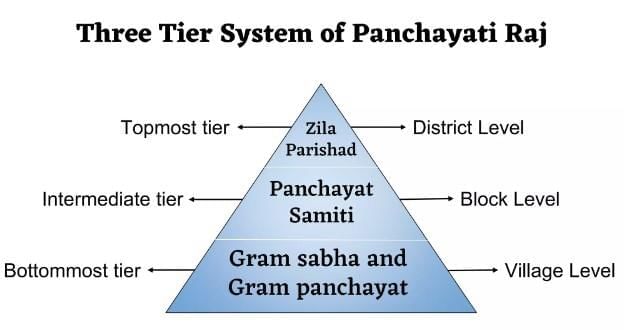Very Short Question Answers: Grassroots Democracy - Part 2: Local Government in Rural Areas | Short & Long Answer Questions for Class 6 PDF Download
Q1: What is the local government system in Indian villages called?
Ans: The local government system in Indian villages is known as the Panchayat.
Q2: How many tiers are there in the Panchayati Raj system?
Ans: There are three tiers in the Panchayati Raj system.
Q3: What is the primary role of the Gram Panchayat?
Ans: The primary role of the Gram Panchayat is to oversee local governance.
Q4: Who elects the members of the Gram Panchayat?
Ans: The members of the Gram Panchayat are elected by the Gram Sabha.
Q5: What is the head of the Gram Panchayat called?
Ans: The head of the Gram Panchayat is called the Sarpanch.
Q6: Which community does Vandana Bahadur Maida belong to?
Ans: Vandana Bahadur Maida belongs to the Bhil community.
Q7: What does the Panchayat Secretary do?
Ans: The Panchayat Secretary is responsible for administrative functions.
Q8: What is the role of a Patwari?
Ans: A Patwari's role is to maintain land records.
Q9: In which state is the Sangkhu Radhu Khandu Gram Panchayat located?
Ans: The Sangkhu Radhu Khandu Gram Panchayat is located in Sikkim.
Q10: What initiative encourages children's participation in village governance?
Ans: The initiative that encourages children's participation in village governance is the Child-Friendly Panchayat Initiative.
Q11: What program helps children learn about democracy in Rajasthan?
Ans: The program that helps children learn about democracy in Rajasthan is called the Children's Parliament.
Q12: What is the function of the Panchayat Samiti?
Ans: The function of the Panchayat Samiti is to coordinate development programs.
Q13: How are members of the Zila Parishad selected?
Ans: Members of the Zila Parishad are elected by local people.
Q14: What ancient text discusses governance and administration?
Ans: The ancient text that discusses governance and administration is the ArthaShastra.
Q15: Who wrote the ArthaShastra?
Ans: The ArthaShastra was written by Kautilya.
Q16: What is a responsibility of the Panchayati Raj system?
Ans: A responsibility of the Panchayati Raj system is to provide support for agriculture.
Q17: How many villages does a sub-district headquarters serve, according to Kautilya?
Ans: According to Kautilya, a sub-district headquarters serves ten villages.
Q18: What is the aim of reserving one-third of seats for women in Panchayati Raj institutions?
Ans: The aim of reserving one-third of seats for women in Panchayati Raj institutions is to promote gender equality.
Q19: Which village adopted rainwater harvesting under its Sarpanch's leadership?
Ans: The village that adopted rainwater harvesting under its Sarpanch's leadership is Hiware Bazar.
Q20: What major issue do Bal Panchayats address in Maharashtra?
Ans: Bal Panchayats in Maharashtra address the major issue of child labour.
FAQs on Very Short Question Answers: Grassroots Democracy - Part 2: Local Government in Rural Areas - Short & Long Answer Questions for Class 6
| 1. What is grassroots democracy in rural areas? |  |
| 2. What roles do local governments play in rural areas? |  |
| 3. How are local government representatives elected in rural areas? |  |
| 4. Why is local self-government important in rural communities? |  |
| 5. What challenges do local governments face in rural areas? |  |

















